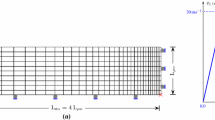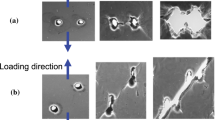Abstract
The modeling of failure in ductile materials must account for complex phenomena at the micro-scale, such as nucleation, growth and coalescence of micro-voids, as well as the final rupture at the macro-scale, as rooted in the work of Gurson (J Eng Mater Technol 99:2–15, 1977). Within a top–down viewpoint, this can be achieved by the combination of a micro-structure-informed elastic–plastic model for a porous medium with a concept for the modeling of macroscopic crack discontinuities. The modeling of macroscopic cracks can be achieved in a convenient way by recently developed continuum phase field approaches to fracture, which are based on the regularization of sharp crack discontinuities, see Miehe et al. (Comput Methods Appl Mech Eng 294:486–522, 2015). This avoids the use of complex discretization methods for crack discontinuities, and can account for complex crack patterns. In this work, we develop a new theoretical and computational framework for the phase field modeling of ductile fracture in conventional elastic–plastic solids under finite strain deformation. It combines modified structures of Gurson–Tvergaard–Needelman GTN-type plasticity model outlined in Tvergaard and Needleman (Acta Metall 32:157–169, 1984) and Nahshon and Hutchinson (Eur J Mech A Solids 27:1–17, 2008) with a new evolution equation for the crack phase field. An important aspect of this work is the development of a robust Explicit–Implicit numerical integration scheme for the highly nonlinear rate equations of the enhanced GTN model, resulting with a low computational cost strategy. The performance of the formulation is underlined by means of some representative examples, including the development of the experimentally observed cup–cone failure mechanism.














Similar content being viewed by others
Notes
For standard von Mises plasticity, the equivalent plastic strain is defined as

Regarding to the relation between the fracture length scale parameter l and the finite element size \(h_e\), we refer to the work of Miehe et. al. [42], where \(l\ge 2 h_e\) is required to resolve the regularized crack surface \(\varGamma _l(d)\), such that we have \(\varGamma _l(d) = \varGamma \) in the finite element approximation.
To overcome the pathological mesh dependency behavior, a non-local GTN damage model can be used, that based on gradient plasticity coupled with fracture phase field, in line with Miehe et. al. [41]. In this approach, a micromororphic regularization on the side of gradient plasticity is introduced by considering an extended set of plastic variables, which are linked by penalty term in a modified energetic response function. This formulation is recently extended towards coupled thermomechanical response of gradient plasticity as outlined in Aldakheel [2] for finite deformations in the logarithmic strain space and Aldakheel and Miehe [4] at small strains.
References
Aldakheel F (2016) Mechanics of nonlocal dissipative solids: gradient plasticity and phase field modeling of ductile fracture. Ph.D. thesis, Institute of Applied Mechanics (CE), Chair I, University of Stuttgart. https://doi.org/10.18419/opus-8803
Aldakheel F (2017) Micromorphic approach for gradient-extended thermo-elastic–plastic solids in the logarithmic strain space. Contin Mech Thermodyn 29(6):1207–1217
Aldakheel F, Mauthe S, Miehe C (2014) Towards phase field modeling of ductile fracture in gradient-extended elastic–plastic solids. Proc Appl Math Mech 14:411–412
Aldakheel F, Miehe C (2017) Coupled thermomechanical response of gradient plasticity. Int J Plast 91:1–24
Alessi R, Marigo JJ, Maurini C, Vidoli S (2017) Coupling damage and plasticity for a phase-field regularisation of brittle, cohesive and ductile fracture: one-dimensional examples. Int J Mech Sci. https://doi.org/10.1016/j.ijmecsci.2017.05.047
Alves M, Jones N (1999) Influence of hydrostatic stress on failure of axisymmetric notched specimens. J Mech Phys Solids 47:643–667
Ambati M, Gerasimov T, De Lorenzis L (2015) Phase-field modeling of ductile fracture. Comput Mech 55:1017–1040
Bai Y, Wierzbicki T (2008) A new model of metal plasticity and fracture with pressure and lode dependence. Int J Plast 24:1071–1096
Becker R, Needleman A, Richmond O, Tvergaard V (1988) Void growth and failure in notched bars. J Mech Phys Solids 36(3):317–351
Beese S, Loehnert S, Wriggers P (2017) 3D ductile crack propagation within a polycrystalline microstructure using XFEM. Comput Mech. https://doi.org/10.1007/s00466-017-1427-y
Belytschko T, Black T (1999) Elastic crack growth in finite elements with minimal remeshing. Int J Numer Methods Eng 45:601–620
Benzerga AA, Leblond JB (2010) Ductile fracture by void growth to coalescence. Adv Appl Mech 44:169–305
Besson J (2010) Continuum models of ductile fracture: a review. Int J Damage Mech 19:3–52
Besson J, Steglich D, Brocks W (2001) Modeling of crack growth in round bars and plane strain specimens. Int J Solids Struct 38:8259–8284
Betegon C, del Coz J, Penuelas I (2006) Implicit integration procedure for viscoplastic gurson materials. Comput Methods Appl Mech Eng 195(44):6146–6157
Borden MJ, Hughes TJ, Landis CM, Anvari A, Lee IJ (2016) A phase-field formulation for fracture in ductile materials: finite deformation balance law derivation, plastic degradation, and stress triaxiality effects. Comput Methods Appl Mech Eng 312:130–166
Borden MJ, Verhoosel CV, Scott MA, Hughes TJR, Landis CM (2012) A phase-field description of dynamic brittle fracture. Comput Methods Appl Mech Eng 217–220:77–95
Duda FP, Ciarbonetti A, Sánchez PJ, Huespe AE (2014) A phase-field/gradient damage model for brittle fracture in elastic–plastic solids. Int J Plast 65:269–296
Ehlers W, Luo C (2017) A phase-field approach embedded in the theory of porous media for the description of dynamic hydraulic fracturing. Comput Methods Appl Mech Eng 315:348–368
Gurson AL (1975) Plastic flow and fracture behavior of ductile materials incorporating void nucleation, growth and coalescence. Ph.D. thesis, Division of Engineering, Brown University, E(11-1) 3084/39
Gurson AL (1977) Continuum theory of ductile rupture by void nucleation and growth, part I—yield criteria and flow rules for porous ductile media. J Eng Mater Technol 99:2–15
Heider Y, Markert B (2017) A phase-field modeling approach of hydraulic fracture in saturated porous media. Mech Res Commun 80:38–46
Hesch C, Weinberg K (2014) Thermodynamically consistent algorithms for a finite-deformation phase-field approach to fracture. Int J Numer Methods Eng 99:906–924
Huespe A, Needleman A, Oliver J, Sánchez PJ (2012) A finite strain, finite band method for modeling ductile fracture. Int J Plast 28:53–69
Kachanov LM (1986) Introduction to continuum damage mechanics. Springer, New York. https://doi.org/10.1007/978-94-017-1957-5
Kojic M, Vlastelica I, Zivkovic M (2002) Implicit stress integration procedure for small and large strains of the gurson material model. Int J Numer Methods Eng 53(12):2701–2720
Kuhn C, Müller R (2011) A new finite element technique for a phase field model of brittle fracture. J Theor Appl Mech 49(4):1115–1133
Leblond J, Perrin G, Devaus J (1995) An improved Gurson-type model for hardenable ductile metals. Eur J Mech A Solids 14:499–527
Lemaitre J (1985) A continuous damage mechanics model for ductile fracture. J Eng Mater Technol 107:83–89
Lemaitre J (1992) A course on damage mechanics. Springer, New York. https://doi.org/10.1007/978-3-642-18255-6
Lemaitre J, Chaboche J (1990) Mechanics of solid materials. Cambridge University Press, Cambridge
Li H, Fu M, Lu J, Yang H (2011) Ductile fracture: experiments and computations. Int J Plast 27:147–180
Linder C, Zhang X (2013) A marching cubes based failure surface propagation concept for three-dimensional finite elements with non-planar embedded strong discontinuities of higher-order kinematics. Int J Numer Methods Eng 96(6):339–372
Mediavilla J, Peerlings R, Geers M (2006) A robust and consistent remeshing-transfer operator for ductile fracture simulations. Comput Struct 84:604–623
Miehe C, Aldakheel F, Raina A (2016) Phase field modeling of ductile fracture at finite strains. a variational gradient-extended plasticity-damage theory. Int J Plast 84:1–32
Miehe C, Aldakheel F, Teichtmeister S (2017) Phase-field modeling of ductile fracture at finite strains: a robust variational-based numerical implementation of a gradient-extended theory by micromorphic regularization. Int J Numer Methods Eng 111(9):816–863
Miehe C, Apel N, Lambrecht M (2002) Anisotropic additive plasticity in the logarithmic strain space: modular kinematic formulation and implementation based on incremental minimization principles for standard materials. Comput Methods Appl Mech Eng 191:5383–5425
Miehe C, Gürses E (2007) A robust algorithm for configurational-force-driven brittle crack propagation with R-adaptive mesh alignment. Int J Numer Methods Eng 72:127–155
Miehe C, Hofacker M, Schänzel LM, Aldakheel F (2015) Phase field modeling of fracture in multi-physics problems. Part II. Brittle-to-ductile failure mode transition and crack propagation in thermo-elastic–plastic solids. Comput Methods Appl Mech Eng 294:486–522
Miehe C, Kienle D, Aldakheel F, Teichtmeister S (2016) Phase field modeling of fracture in porous plasticity: a variational gradient-extended eulerian framework for the macroscopic analysis of ductile failure. Comput Methods Appl Mech Eng 312:3–50
Miehe C, Teichtmeister S, Aldakheel F (2016) Phase-field modeling of ductile fracture: a variational gradient-extended plasticity-damage theory and its micromorphic regularization. Philos Trans R Soc Lond A Math Phys Eng Sci. https://doi.org/10.1098/rsta.2015.0170
Miehe C, Welschinger F, Hofacker M (2010) Thermodynamically consistent phase-field models of fracture: variational principles and multi-field FE implementations. Int J Numer Methods Eng 83:1273–1311
Moës N, Dolbow J, Belytschko T (1999) A finite element method for crack growth without remeshing. Int J Numer Methods Eng 46:131–150
Mosler J (2004) On the modeling of highly localized deformations induced by material failure: the strong discontinuity approach. Arch Comput Methods Eng 11:389–446
Mosler J, Meschke G (2003) 3D modelling of strong discontinuities in elastoplastic solids: fixed and rotating localization formulations. Int J Numer Methods Eng 57:1553–1576
Nahshon K, Hutchinson J (2008) Modification of the Gurson model for shear failure. Eur J Mech A Solids 27:1–17
Needleman A, Tvergaard V (1984) An analysis of ductile rupture in notched bars. J Mech Phys Solids 32:461–490
Oliver J, Huespe A, Blanco S, Linero D (2005) Stability and robustness issues in numerical modeling of material failure with the strong discontinuity approach. Comput Methods Appl Mech Eng 195:7093–7114
Ortiz M, Pandolfi A (1999) Finite-deformation irreversible cohesive elements for three-dimensional crack-propagation analysis. Int J Numer Methods Eng 44:1267–1282
Pham K, Amor H, Marigo J, Maurini C (2011) Gradient damage models and their use to approximate brittle fracture. Int J Damage Mech 20(4):618–652
Reinoso J, Paggi M, Linder C (2017) Phase field modeling of brittle fracture for enhanced assumed strain shells at large deformations: formulation and finite element implementation. Comput Mech 59(6):981–1001
Reusch F, Svendsen B, Klingbeil D (2003) Local and non-local Gurson-based ductile damage and failure modelling at large deformation. Eur J Mech A Solids 22:779–792
Sánchez PJ, Huespe AE, Oliver J (2008) On some topics for the numerical simulation of ductile fracture. Int J Plast 24:1008–1038
Simo JC, Oliver J, Armero F (1993) An analysis of strong discontinuities induced by strain-softening in rate-independent inelastic solids. Comput Mech 12:277–296
Teichtmeister S, Kienle D, Aldakheel F, Keip MA (2017) Phase field modeling of fracture in anisotropic brittle solids. Int J Nonlinear Mech 97:1–21
Tvergaard V (1982) On localization in ductile materials containing spherical voids. Int J Fract 18:237–252
Tvergaard V, Needleman A (1984) Analysis of the cup-cone fracture in a round tensile bar. Acta Metall 32:157–169
Verhoosel CV, de Borst R (2013) A phase-field model for cohesive fracture. Int J Numer Methods Eng 96:43–62
Wick T (2017) Modified newton methods for solving fully monolithic phase-field quasi-static brittle fracture propagation. Comput Methods Appl Mech Eng 325:577–611
Xue L, Wierzbicki T (2008) Ductile fracture initiation and propagation modeling using damage plasticity theory. Eng Fract Mech 75:3276–3293
Xue Z, Pontin M, Zok F, Hutchinson J (2010) Calibration procedures for a computational model of ductile fracture. Eng Fract Mech 77:492–509
Zhang Z (1995) On the accuracies of numerical integration algorithms for gurson-based pressure-dependent elastoplastic constitutive models. Comput Methods Appl Mech Eng 121(1):15–28
Acknowledgements
F. A. wants to thank the late Professor Christian Miehe, whose continuous scientific support and great mentorship will always be remembered. Support for this research was provided by the “German Research Foundation” (DFG) within project WR 19/58-1.
Author information
Authors and Affiliations
Corresponding author
Rights and permissions
About this article
Cite this article
Aldakheel, F., Wriggers, P. & Miehe, C. A modified Gurson-type plasticity model at finite strains: formulation, numerical analysis and phase-field coupling. Comput Mech 62, 815–833 (2018). https://doi.org/10.1007/s00466-017-1530-0
Received:
Accepted:
Published:
Issue Date:
DOI: https://doi.org/10.1007/s00466-017-1530-0





